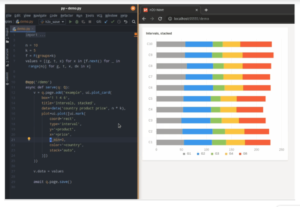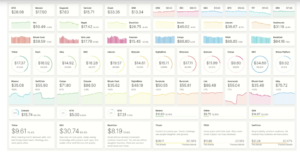
H2O Wave: A New UI for AI

(Oleksii Lishchyshyn/Shutterstock)
AI and machine learning by themselves do not move the needle. The technologies must be applied somehow to have the desired impact. With that in mind, H2O.ai today unveiled an open-source Python development framework called H2O Wave for creating new user interfaces (UIs) for AI applications and connecting the dots between data science insight and real world impact.
Data scientists have an abundance of tools and technology for exploring data and building machine learning models, including things like PyTorch, TensorFlow, and the popular H2O library (not to mention the company’s Driverless AI offering). But when it comes to building compelling user interfaces that bring those ML models to life, there aren’t as many options available, according to H2O.ai founder and CEO SriSatish Ambati.
“One of the things we observed is our customer build incredible data science kernels, notebooks and brilliant insights, but they’re unable to present it to business users, or they’re unable to get the business to make decisions,” Ambati tells Datanami. “We need to start making it simpler, making it consumable by business professionals and everybody.”
In other words, AI needs a new Web-based UI, he says. That’s the goal behind H2O Wave. “It makes Python ML application developers prolific app builders,” he says.
AI Apps 4 All
H2O Wave enables users to create rich Web experiences, interactive charts, and dashboards that are closely linked to Python-based machine learning models, including the ones mentioned above. Support for R-based ML models is on the company’s roadmap.
The software supports open-source visualization frameworks, such as D3, Bokeh, and MatPlotLib. It includes an assortment of dialogs, themes, and widgets to enable developers to create rich experiences based on the output from ML models, without requiring the user to be an expert in Web technologies like HTML, JavaScript, and CSS.
Ambati envisions H2O Wave being used in a variety of different industries. For example, banks could use it to build apps that help search for fraud or investment opportunities, while a hospital could use it to work with data associated with a drug trial.
“You don’t need to move the data out of the hospital,” he says. “Move the model to the hospital.”
The software, which is free, will ship out of the box with a handful of pre-built applications, including: Social Media Sentiment; Explaining Ratings; Getting Started with NLP; Getting Started with Images; Mitigating Churn Risk; Human-in-the-Loop Credit Risk; Online Shopping Recommendations; and Guess the Number.
Of course, users will likely get more traction out of the software by creating their own applications, but these pre-built apps providing a starting point for exploration.
Feedback Loop
H2O Wave completes a feedback loop of sorts for H2O and its customers. As users interact with the H2O Wave apps, it generates more data, which in turn can be incorporated into the ML models to improve on the predictions, recommendations, or whatever ML-based activity is at the core of the app.
“The fuel of AI is data, but the output of AI is also creating more data that is even more personalized or ready for a decision,” Ambati says. “It’s that ability to create new data, to collect new [forms] of customer-centric feedback, so that that partial user experience becomes richer or even smoother.”
The open source nature of H2O Wave will enable users to build compelling UIs and AI apps without fear that those UIs and apps will only be accessible within a walled garden, according to Ambati.
“Today customers have a choice or locking into a Looker or Qlik or Tableau ecosystem,” he says. “With open source, they’re able to unleash that productivity in the language that data scientists are comfortable with, and also make their apps their own so they’re not locked in.”
A collection of about 150 connectors will enable H2O Wave apps to tap into data stored in external data stores, including data warehouses like those from Snowflake, Teradata, and Oracle. That will further round out the offering, as well as help bring data engineers into the mix alongside the other two groups of users, namely data scientists and Web developers, Ambati says.
H2O App Store
The launch of H2O Wave is also the opening salvo in H2O’s goal to host an AI app store that’s tied to an H2O cloud offering. The plan is to launch the app store next month, Ambati says.
“The purpose of Wave is to democratize AI apps so you can build those faster, cheaper, and easier,” he says. “The first hundred apps, we built here in H2O. We expect to have thousands of apps by the same time next year.”
It’s much easier to find folks who are proficient in Python than it is to find data scientists (although data scientists themselves can also use H2O Wave). This is one of the reasons why H2O sees an app store as the natural result of enabling organizations to churn out more polished AI apps at a much higher rate than they did before.
“The biggest problem we have always faced with big data was not its scale, not its ability to run smoothly and collect data inexpensively. It was an inability to create a rich application ecosystem,” Ambati says. “That’s why H2O Wave, while it’s a small investment for us, is a giant step for creating consumption in AI and being more prolific.”
The Go-based H2O Wave software also supports a synchronous server, which enables users to update thousands of dashboards simultaneously thanks to support for Web sockets. This will enable H2O Wave dashboards to be tied to vast networks of IoT sensors deployed on the edge, Ambati says.
“Our view of the world is that AI is headed to the edge and the edge needs more visibility,” he says. “It’s exciting to us. We’re makers and developers. We think this is just the beginning.”
H2O Wave is open source and free to use. You can give it a shot at H2O’s website or at its GitHub site.
Related Items:
Webinar: Data + AI Lessons Learned from Covid-19
H2O.ai Tops Off Funding to Accelerate AI Adoption
On-Ramp to AI: The Path to Democratize AI Starts with One Class




























